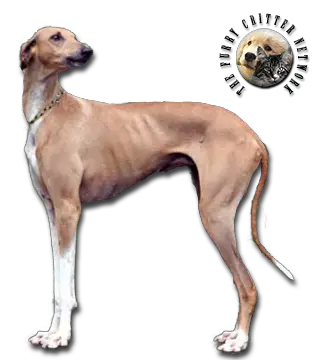Breed Standard
Head: Long, narrow, slender, cleanly cut, chiseled. Skull nearly flat, fairly long. Prominent occipital peak. Stop not very pronounced. Long, straight muzzle. Long, b jaws. Flat cheeks. Black or brown nose.
Ears: Set on high. Thin, pendulous, lying flat against the head, never rose-shaped.
Eyes: Fairly large, almond-shaped. Dark or amber-colored. Pigmented eyelids.
Body: Long. Neck long, slender, muscular, slightly arched, without dewlap. Prominent withers. Brisket not very wide. Chest long, high, not very broad. Long, visible ribs. Short, cleanly cut, slightly arched loin. Prominent hips slightly higher than the withers. Pronounced tuck-up. Short, straight back. Croup slanted but not sloping.
Tail: Set on low, long, thin, cleanly cut, and tapering. Hanging with the tip slightly raised. May be carried above the topline in action.
Hair: Close-lying, fine, sparse to absent on the abdomen.
Coat: Fawn with limited patching on the extremities. All shades are allowed, from light sand to dark fawn. Possible black mask on the head and very uneven flare. White chest and white tuft at the tip of the tail. White stockings required on each leg, at least as a trace on the feet. Black streaks are allowed.
Size: Dog: 64 to 74 cm. (25-29 in).Bitch: 60 to 70 cm. (23.5-27.5 in).
Weight: Dog: 20 to 25 kg. (44-55 lb).Bitch: 15 to 20 kg. (33-44 lb).
History
This African sighthound comes from the middle Nigerian Basin in the Azawakh Valley on the border of Mali. The breed was developed by the Tuaregs of the southern Sahara to trip gazelles so that horsemen could catch them. The Azawakh was also used in ceremonies and kept as a pet. He is a close cousin to the Arabian Greyhound and the Saluki. The first Azawakhs were imported to Europe in the early 1970s. The breed was officially recognized by the FCI in 1981, and a standard was published in 1982.
The breed was admitted to the American Kennel Club in 1936. This quaint little dog's popularity has been overshadowed by that of his descendent, the Brussels Griffon, but more recently he is enjoying a return to favor.
Behavior
Azawakhs have a range of temperaments from lap dog to quite fierce. Lifelong socialization and gentle handling are critical. Well socialised and trained, they can be good with other dogs, cats, children, and strangers.
Unlike other sighthounds, the primary function of the Azawakh in its native land is that of protector. It develops an intense bond with its owner, yet can perform independently from its master. With those they accept, Azawakh are gentle and extremely affectionate. With strangers many are reserved and prefer not to be touched, but are not inherently aggressive. Although raised to guard against predators, they do not have innate aggression toward canines or humans unless they are threatened.
Azawakh have high energy and tremendous endurance. They are excellent training companions for runners. Many Azawakh dislike rain and cold weather.
Azawakh are pack oriented and form complex social hierarchies. They have tremendous memories and are able to recognize each other after long periods of separation. They can often be found sleeping on top of each other for warmth and companionship
He should not be confined to an apartment. He needs space and lots of exercise, as well as weekly brushing.
Function
Hunting Dog, Companion Dog.
Health
Azawakhs are an incredibly sound coursing hound. There is a small occurrence of adult-onset idiopathic epilepsy in the breed. Wobbler disease, or cervical vertebral instability, does rarely occur. Some breeders believe this is largely a developmental problem where puppies grow too quickly due to a high-protein Western diet.






